|
Nakajima Aircraft was expanding continuously, and reorganized
itself in 1931 by forming the partnership firm "Nakajima
Aircraft Industries Ltd.", using a capital of 6 million
yen. In 1934, a new large-scale factory was completed in the
central part of Ota City in Gunma Prefecture and its headquarters
was set there. From the east entrance, the Navy plane engineering group was located on the left. Chief Engineers (Mitake, Akegawa, Fukuda, Inoue, Yamamoto, Matsubayashi and Nakamura) sat down in the middle of the room and delivered their ideas while issuing instructions to the drafting engineers located on both side of them. Proceeding further to the west of the building, passing through the middle hall, there was the Army plane group where Chief Engineers (Koyama, Mori, Nishimura, Matsuda, Ota, Aoki, Ichimaru, Uchida and Dodo) sat down. Though they were the top echelon of the group, all of them were youngsters between the age of 25 to 35, almost fresh from school. Back then, jobs were done through a project team that was organized for each plane, and all members handled all areas of engineering, such as body construction, electric equipment, and armaments. But separate groups were designated for aerodynamics and weight. Hideo Itokwa, who became famous in a rocket science after the war, was in the aerodynamics group. This period was the best time for the young engineers with a climate for challenging innovation freely and openly. There were a bunch of brave engineers, especially within the Navy plane group, many of whom graduated from Aeronautics of Tokyo University. All of them were hot and daring young men with strong personalities. On the other hand, the Army plane group had mainly graduates from Tohoku University such as Tei Koyama and Jingo Kuribara. They were as calm, cool-headed, and Spartan, but in other words, they were a very square and conservative engineering group. (Professor Hideo Itokawa said at a lecture after the war that "Mitsubishi is characterized by organization, while Nakajima is characterized by personality".)
In accordance with government principles to increase aircraft production, the Ota Factory was greatly expanded, and the Musashino Factory was established solely for Army engine manufacturing in 1938. The Navy was influenced by this and issued a command to expand the Navy factory independently. The Tama Factory for engine production and the Koizumi Factory (current Oizumi in Gunma Prefecture, shown in the picture) for body construction were built in 1940. The Koizumi Factory was the largest in the Orient with an area of 1,320,000m2, and produced mainly "Zero" fighters (engineered by Mitsubishi) with Nakajima "Sakae" engines. Also other planes; the "Gekko (moonlight)", the "Ginga (galaxy)", the "Tenzan (Tian Shan, Chinese mountains)", the "Saiun (iridescent clouds)" , and others totaling about 9,000 units were manufactured at the plant. The number of employees there, in the end, totaled more than 60,000. Every time a plane was completed, its large door (30m in width, more than 15m in height) was opened and all employees would see it off by singing the national anthem and the company song at a ceremony. (Later this custom was banned by the military in order to prevent espionage.) The engineering division moved out from the third floor of the main building in the Ota Factory. The Army plane group moved to a newly built three-story building adjacent to the main building, and the Navy plane group moved to the Koizumi Factory. Developmental organization was changed from an one-plane/one-team method to a specialized group method that focussed on each function separately, such as an Aerodynamics Team, a Weight Team, a Structure Team, a Power Unit Team, a Landing Gear Team, a Control Team, an Electric Equipment Team, an Armaments Team, etc. Also a Total Management Team was established to promote standardization for a more efficient development process. Nakajima proposed again and again to standardize the Army and the Navy parts, but due to their egos, neither the Army nor the Navy compromised, and Nakajima had to put up with the inefficiency. (Separate page: Vicissitude of Nakajima Body Plant) When a manufacturing order for a new plane prototype came form the military, The Aerodynamics Team established the basic concept, the Weight Team set the target value, and a three-view drawing was made. It was then circulated to other teams. More often than not, the Structure Team initiated a debate that "It is impossible to make a plane with the weight specified by the Weight Team". Through the heated discussions of what is "Possible" and "Impossible", the target value was more or less achieved in the end. In those days, there were no computers, and all they had to work with were slide rules. The slide rules they used were much longer than normal, having a length of 50 to 60cm. They boasted that "Samurai wear Katanas, but we wear Slide-rules!" They always carried a small slide rule in their chest pocket. The accuracy of slide rules was more than sufficient, considering the manufacturing allowance. But when precision was required, they ran a Tiger-calculator (a manual calculating machine that does multiplication or division by repeating addition or subtraction) from morning till night. (Engineer, Mr. Aoki said.) Evaluation tests for Army approval were normally done at Tachikawa Airfield. Just after the test, the pilot who finished the test flight stood in front of the senior officer and reported the results loudly with a salute. On the side, Nakajima engineers would listen to the report carefully, and worked out remedies instantly on the spot. Then they would call Ota to gather all the necessary personnel, and drive back to Ota through Kumagaya, crossing the Tone River. The necessary parts were manufactured through the night and many a time, they were seen driving back to the site early the next morning with a horizontal stabilizer lashed down on the roof of the car. They often would install the new parts just in time for the tests. But the most exciting event was when their airplane was evaluated against other competitors in dog-fight tests or performance tests. The results were "Win!" or "Lose!" and all engineers were really enthusiastic and ardent about their work. The engineers in charge of developing a plane were strictly prohibited to ride as a rule, especially on the maiden flight, but it is said that they got on board occasionally to make confirmation tests in cold weather tests in Manchuria or hot weather tests in the south areas. 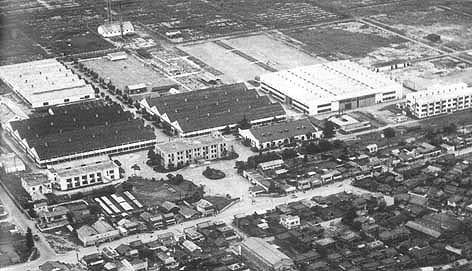 A panoramic view of Ota Factory (The main building is in the middle, the new engineering building is on the right end of the row, and the strength testing room is located on the far left.) Although Nakajima Aircraft is famous in the field of combat aircraft, the production of civil aircraft is hardly mentioned. One of Nakajima's most highly important civilian aircraft was the AT-2 passenger transport plane. Even though its basic design was based on that of U.S.A. DC-2, its construction was very innovative. It was named AT (Akegawa Transport) after its chief engineer, Kiyoshi Akegawa. The first AT made its maiden flight successfully at Ojima airfield. From that point on, improvements were taken over by Chief Engineer, Setsuo Nishimura, and the AT became an excellent mid-class passenger plane with superior performance with regard to controllability and stability. This plane was used by Japan Airlines before the war and was sometimes named "Asama", "Kashima", "Hakozaki", "Kumano", or "Izumo" after the famous sightseeing spot in Japan. It was also adopted as a transport airplane by the Army.
During Army and the Navy airplane competitions, the historic Type 97 fighter was born. It could be said that it is the most important achievement in Nakajima Aircraft's history. At that time, there was a lot of controversy within the company regarding which wing type would be better, that of a biplane or a monoplane. The same debate applied to overseas airplane industries, and the trend, at that time, leaned toward a biplane putting more emphasis on dog-fight performance. With this situation at hand, Chief Engineer Tei Koyama, with the cooperation of young engineers such as Chief Engineer Minoru Ota and Hideo Itokawa, developed the "Ki-27". It had an innovative body structure and a unique wing construction using a new wing shape with a straight front edge line, based on a new wing theory. This plane defeated ones manufactured by Mitsubishi and Kawasaki, and became the third Nakajima plane to be adopted. The Type 97 fighter excelled not only in the maneuverability due to its light weight, but also in maintainability. It established high utilization rate and achieved good results duaring the Nomonhan Incident and during the early stage of World War II. Its main wing was constructed into a single piece, made separately from the body, and assembled later. This improved the productivity greatly. At one time, a stream of new planes were supplied to the battlefront and no more pilots were available to fly the planes. The unique wing theory applied to the Type 97 fighter and all fighters made afterward. 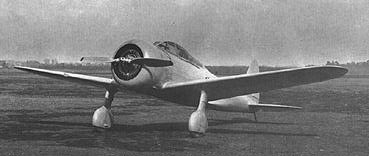 Type 97 Fighter Type 97 FighterFrom 1938 to 1942, a total of 3,386 Type 97 fighters were produced; 2,007 units by Nakajima, and 1,379 units by Tachikawa Aircraft and Manchuria Aircraft. |
 The area was 45,000 tsubo (150,000m2). The then modern, three-story main building
in the front (now being used as the current Gunma Manufacturing
Division of Fuji Heavy Industries Ltd.) was designed in the shape
of an airplane as seen from a bird's-eye view. In this building,
the Engineering and Development Department was located on the
third floor.
The area was 45,000 tsubo (150,000m2). The then modern, three-story main building
in the front (now being used as the current Gunma Manufacturing
Division of Fuji Heavy Industries Ltd.) was designed in the shape
of an airplane as seen from a bird's-eye view. In this building,
the Engineering and Development Department was located on the
third floor.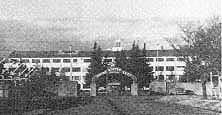 These engineers worked together around the Senior
Chief Engineer and had liaison meetings to establish lateral
communication. They also formed Gishi-kai (senior engineers association).
This Gishi-kai was occasionally more powerful than the member
of the board meeting of the company, and sometimes rejected the
decisions made by the board. For this reason, many people relied
heavily on this group. But there was still some competitive feeling
between the Army group and the Navy group. Both engineering groups
would often play a friendly game of "Go" at lunch time,
but avoided talking about the content of their work. The engineers
supporting the Gishi-kai were only high school or technical school
graduates from the Kanto or Tohoku region, but all of them were
first in their class and very capable engineers.
These engineers worked together around the Senior
Chief Engineer and had liaison meetings to establish lateral
communication. They also formed Gishi-kai (senior engineers association).
This Gishi-kai was occasionally more powerful than the member
of the board meeting of the company, and sometimes rejected the
decisions made by the board. For this reason, many people relied
heavily on this group. But there was still some competitive feeling
between the Army group and the Navy group. Both engineering groups
would often play a friendly game of "Go" at lunch time,
but avoided talking about the content of their work. The engineers
supporting the Gishi-kai were only high school or technical school
graduates from the Kanto or Tohoku region, but all of them were
first in their class and very capable engineers.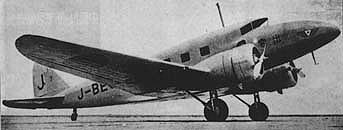
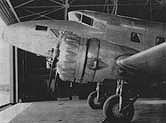 Nakajima AT-2 passenger transporter
Nakajima AT-2 passenger transporter